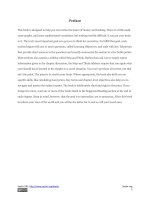Money and Banking: Lecture 10
Bạn đang xem bản rút gọn của tài liệu. Xem và tải ngay bản đầy đủ của tài liệu tại đây (672.1 KB, 32 trang )
Money and Banking
Lecture 10
Review of the Previous Lecture
• Application of Present Value Concept
• Compound Annual Rate
• Interest Rates vs Discount Rate
• Internal Rate of Return
Topics under Discussion
• Application of Present Value Concept
• Bond Pricing
• Real Vs Nominal Interest Rates
• Risk
• Characteristics
• Measurement
Bond Pricing
• A bond is a promise to make a series of
payments on specific future date.
• It is a legal contract issued as part of an
arrangement to borrow
• The most common type is a coupon bond,
which makes annual payments called
coupon payments
• The percentage rate is called the coupon rate
• The bond also specifies a maturity date (n)
and has a final payment (F), which is the
principal, face value, or par value of the bond
Bond Pricing
• The price of a bond is the present value of
its payments
• To value a bond we need to value the
repayment of principal and the payments
of interest
Bond Pricing
• Valuing the Principal Payment:
• a straightforward application of present value
where n represents the maturity of the bond
• Valuing the Coupon Payments:
• requires calculating the present value of the
payments and then adding them; remember,
present value is additive
• Valuing the Coupon Payments plus
Principal:
• means combining the above
Bond Pricing
Payment stops at the maturity date. (n)
A payment is for the face value (F) or
principle of the bond
Coupon Bonds make annual payments
called, Coupon Payments (C), based upon
an interest rate, the coupon rate (i c),
C=ic*F
Bond Pricing
A bond that has a $100 principle payment in n
years. The present value (PBP) of this is now:
PBP
F
n
(1 i )
$100
n
(1 i )
Bond Pricing
If the bond has n coupon payments (C), where
C= ic * F, the Present Value (PCP) of the coupon
payments is:
PCP
C
(1 i )1
C
(1 i ) 2
C
(1 i ) 3
C
......
(1 i ) n
Bond Pricing
Present Value of Coupon Bond (PCB) =
Present value of Yearly Coupon Payments (PCP)
+
Present Value of the Principal Payment (PBP)
PCB PCP PBP
C
C
C
C
......
1
2
3
(1 i) (1 i) (1 i)
(1 i) n
F
(1 i) n
Bond Pricing
Note:
• The value of the coupon bond rises when
the yearly coupon payments rise and
when the interest rate falls
• Lower interest rates mean higher bond
prices and vice versa.
• The value of a bond varies inversely with
the interest rate used to discount the
promised payments
Real and Nominal Interest Rates
• So far we have been computing the present
value using nominal interest rates (i), or
interest rates expressed in current-dollar
terms
• But inflation affects the purchasing power of
a dollar, so we need to consider the real
interest rate (r), which is the inflationadjusted interest rate.
• The Fisher equation tells us that the nominal
interest rate is equal to the real interest rate
plus the expected rate of inflation
Real and Nominal Interest Rates
Fisher Equation:
i = r + πe
or
r = i - πe
Real and Nominal Interest Rates
Real and Nominal Interest Rates
Risk
• Every day we make decisions that involve
financial and economic risk.
• How much car insurance should we buy?
• Should we refinance the home loan now or a
year from now?
• Should we save more for retirement, or spend
the extra money on a new car?
Risk
• Interestingly enough, the tools we use today to
measure and analyze risk were first developed
to help players analyze games of chance.
• For thousands of years, people have played
games based on a throw of the dice, but they
had little understanding of how those games
actually worked
• Since the invention of probability theory, we
have come to realize that many everyday
events, including those in economics, finance,
and even weather forecasting, are best thought
of as analogous to the flip of a coin or the throw
of a die
Risk
• Still, while experts can make educated guesses
about the future path of interest rates, inflation,
or the stock market, their predictions are really
only that—guesses.
• And while meteorologists are fairly good at
forecasting the weather a day or two ahead,
economists, financial advisors, and business
gurus have dismal records.
• So understanding the possibility of various
occurrences should allow everyone to make
better choices. While risk cannot be eliminated,
it can often be managed effectively.
Risk
• Finally, while most people view risk as a curse to be
avoided whenever possible, risk also creates
opportunities.
• The payoff from a winning bet on one hand of cards can
often erase the losses on a losing hand.
• Thus the importance of probability theory to the development
of modern financial markets is hard to overemphasize.
• People require compensation for taking risks. Without the
capacity to measure risk, we could not calculate a fair price
for transferring risk from one person to another, nor could we
price stocks and bonds, much less sell insurance.
• The market for options didn't exist until economists learned
how to compute the price of an option using probability
theory
Risk
• We need a definition of risk that focuses
on the fact that the outcomes of financial
and economic decisions are almost
always unknown at the time the decisions
are made.
• Risk is a measure of uncertainty about
the future payoff of an investment,
measured over some time horizon
and relative to a benchmark.
Risk
•
Characteristics of risk
•
•
•
•
Risk can be quantified.
Risk arises from uncertainty about the
future.
Risk has to do with the future payoff to an
investment, which is unknown.
Our definition of risk refers to an investment
or group of investments.
Risk
• Characteristics of risk
• Risk must be measured over some time
horizon.
• Risk must be measured relative to some
benchmark, not in isolation.
• If you want to know the risk associated with
a specific investment strategy, the most
appropriate benchmark would be the risk
associated with other investing strategies
Measuring Risk
Measuring Risk requires:
• List of all possible outcomes
• Chance of each one occurring.
• The tossing of a coin
• What are possible outcomes?
• What is he chance of each one occurring?
• Is coin fair?
Measuring Risk
• Probability is a measure of likelihood that an
even will occur
• Its value is between zero and one
• The closer probability is to zero, less likely it is that
an event will occur.
• No chance of occurring if probability is exactly zero
• The closer probability is to one, more likely it is that
an event will occur.
• The event will definitely occur if probability is exactly
one
• Probabilities can also be expressed as
frequencies
Measuring Risk
We must include all possible outcomes when
constructing such a table









